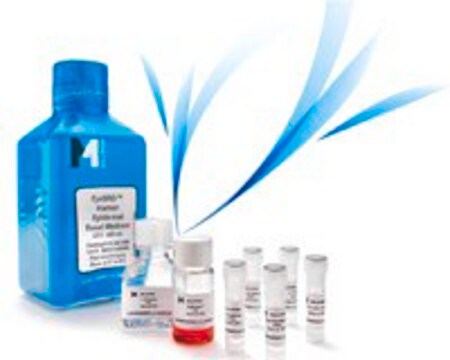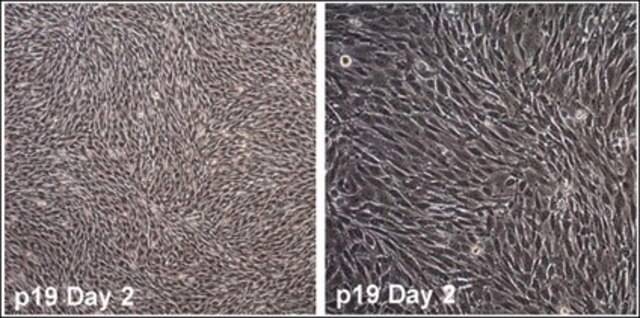おすすめの製品
product name
CT-2Aマウス神経膠腫細胞株, CT-2A mouse glioma cell line is a valuable mouse model for therapeutic research on brain malignancies.
由来生物
mouse
テクニック
cell culture | mammalian: suitable
輸送温度
ambient
詳細
CT-2A細胞株は、皮下の非転移性マウス神経膠腫(星状細胞腫)由来です。由来する腫瘍は、高い血管分布度と悪性度を伴う低分化として分類されています(2)。 CT-2A細胞の特徴には、高レベルのガングリオシド複合体と低分散の抗血管新生ガングリオシドGM3があり、さらに腫瘍抑制因子PTEN/TSC2の欠乏、最大で70%のヒト高悪性度神経膠腫細胞株における特徴的存在が挙げられます(3,4)。 CT-2A腫瘍はp53の野生型であり、ヒト高悪性度神経膠腫のいくつかの特徴、例えば高い有糸分裂指数と細胞密度、核の多形性、出血、偽柵状配列壊死、および微小血管増殖などを反復します(5,6)。
起源:
CT-2Aは、発がん物質の20-メチルコラントレンをC57BL/6Jマウスの大脳に植え込むことにより形成された、悪性星状細胞腫から生成されています(7)。 腫瘍は、細胞株単離の前に連続して頭蓋内移植を行うことで維持されました。
起源:
CT-2Aは、発がん物質の20-メチルコラントレンをC57BL/6Jマウスの大脳に植え込むことにより形成された、悪性星状細胞腫から生成されています(7)。 腫瘍は、細胞株単離の前に連続して頭蓋内移植を行うことで維持されました。
膠芽細胞腫は、低い治療効果と生存率を伴う最も攻撃的ながんの形態です。再発性膠芽細胞腫は、一次化学療法に対してしばしば耐性を示します(1)。 効果的な治療法の開発に向けた取り組みのなかで、膠芽細胞腫の薬物耐性型の研究に多くの関心が集まっています。
参考文献:
1. Weller M, Cloughesy T, Perry JR, and Wick W (2013).Neuro Oncol 15(1): 4-27.
2. Seyfried TN, el-Abbadi M, and Roy ML (1992).Mol Chem Neuropathol 17(2):147-167.
3. Seyfried TN, Mukherjee P (2010).J Oncol 2010:961243 doi.10.1155/2010/961243.
4. Cotterchio M, Seyfried TN (1994).J Lipid Res 35(1): 10-14.
5. Binello E, Qadeer ZA, Kothari HP, Emdad L, Germano IM (2012).J Cancer 3: 166-174.
6. Martinez-Murillo R, Martinez A (2007).Histol Histopathol 22(12): 1309-1326.
7. Zimmerman HM and Arnold H. (1941).Cancer Res 1(12): 919-938.
参考文献:
1. Weller M, Cloughesy T, Perry JR, and Wick W (2013).Neuro Oncol 15(1): 4-27.
2. Seyfried TN, el-Abbadi M, and Roy ML (1992).Mol Chem Neuropathol 17(2):147-167.
3. Seyfried TN, Mukherjee P (2010).J Oncol 2010:961243 doi.10.1155/2010/961243.
4. Cotterchio M, Seyfried TN (1994).J Lipid Res 35(1): 10-14.
5. Binello E, Qadeer ZA, Kothari HP, Emdad L, Germano IM (2012).J Cancer 3: 166-174.
6. Martinez-Murillo R, Martinez A (2007).Histol Histopathol 22(12): 1309-1326.
7. Zimmerman HM and Arnold H. (1941).Cancer Res 1(12): 919-938.
細胞株の説明
がん細胞
アプリケーション
この製品は、製品文書に詳述されている「学術的使用に関する協約」の条件に従って、内部の学術研究に使用することを意図して、学術機関のみに販売されています。その他の使用に関する情報については、licensing@emdmillipore.comをご覧ください。
研究のカテゴリ
がん
腫瘍学
がん
腫瘍学
品質
• 各バイアルには≥1X10⁶個の生存細胞が含まれています。
• 細胞は、Charles River Animal Diagnostic ServicesのMouse Essential CLEARパネルにより感染症に関して陰性であることがテストされています。
• 細胞は、マウス起源であること、およびラット、チャイニーズハムスター、ゴールデンシリアンハムスター、ヒトおよびヒト以外の霊長類(NHP)による種間汚染に関して陰性であることが、Charles River Animal Diagnostic ServicesのContamination CLEARパネルによる評価に従って検証されています。
• 細胞はマイコプラズマ汚染に関して陰性です。
• 細胞は、Charles River Animal Diagnostic ServicesのMouse Essential CLEARパネルにより感染症に関して陰性であることがテストされています。
• 細胞は、マウス起源であること、およびラット、チャイニーズハムスター、ゴールデンシリアンハムスター、ヒトおよびヒト以外の霊長類(NHP)による種間汚染に関して陰性であることが、Charles River Animal Diagnostic ServicesのContamination CLEARパネルによる評価に従って検証されています。
• 細胞はマイコプラズマ汚染に関して陰性です。
保管および安定性
液体窒素中で保存してください。細胞は、初回の融解後に少なくとも10回継代して、細胞マーカーの発現と機能性に重大な影響を与えることなく培養できます。
免責事項
メルクのカタログまたは製品に添付されたメルクのその他の文書に記載されていない場合、メルクの製品は研究用途のみを目的としているため、他のいかなる目的にも使用することはできません。このような目的としては、未承認の商業用途、in vitroの診断用途、ex vivoあるいはin vivoの治療用途、またはヒトあるいは動物へのあらゆる種類の消費あるいは適用などがありますが、これらに限定されません。
保管分類コード
12 - Non Combustible Liquids
WGK
WGK 2
引火点(°F)
does not flash
引火点(℃)
does not flash
適用法令
試験研究用途を考慮した関連法令を主に挙げております。化学物質以外については、一部の情報のみ提供しています。 製品を安全かつ合法的に使用することは、使用者の義務です。最新情報により修正される場合があります。WEBの反映には時間を要することがあるため、適宜SDSをご参照ください。
Jan Code
SCC194:
試験成績書(COA)
製品のロット番号・バッチ番号を入力して、試験成績書(COA) を検索できます。ロット番号・バッチ番号は、製品ラベルに「Lot」または「Batch」に続いて記載されています。
Michael Weller et al.
Neuro-oncology, 15(1), 4-27 (2012-11-09)
Newly diagnosed glioblastoma is now commonly treated with surgery, if feasible, or biopsy, followed by radiation plus concomitant and adjuvant temozolomide. The treatment of recurrent glioblastoma continues to be a moving target as new therapeutic principles enrich the standards of
R Martínez-Murillo et al.
Histology and histopathology, 22(12), 1309-1326 (2007-08-21)
Animal models of glial-derived neoplasms are needed to study the biological mechanisms of glioma tumorigenesis and those that sustain the disease state. With the aim to develop and characterize a suitable in vivo experimental mouse model for infiltrating astrocytoma, with
Aleksei A Stepanenko et al.
Molecular therapy oncolytics, 24, 230-248 (2022-01-25)
Ad5-delta-24-RGD is currently the most clinically advanced recombinant adenovirus (rAd) for glioma therapy. We constructed a panel of fiber-modified rAds (Ad5RGD, Ad5/3, Ad5/35, Ad5/3RGD, and Ad5/35RGD, all harboring the delta-24 modification) and compared their infectivity, replication, reproduction, and cytolytic efficacy
M Cotterchio et al.
Journal of lipid research, 35(1), 10-14 (1994-01-01)
The content of serum gangliosides was examined in VM and C57BL/6J (B6) mice that contained subcutaneous metastatic (VM) and non-metastatic (CT-2A) brain tumors, respectively. Gas-liquid chromatography (GLC) and high performance thin-layer chromatography (HPTLC) were used to analyze the serum gangliosides.
Emanuela Binello et al.
Journal of Cancer, 3, 166-174 (2012-04-20)
Evidence has pointed to brain tumor stem cells (BTSC) as culprits behind human high-grade glioma (hHGG) resistance to standard therapy. Pre-clinical rodent models are the mainstay for testing of new therapeutic strategies. The typical model involves the intracranial injection of
ライフサイエンス、有機合成、材料科学、クロマトグラフィー、分析など、あらゆる分野の研究に経験のあるメンバーがおります。.
製品に関するお問い合わせはこちら(テクニカルサービス)








